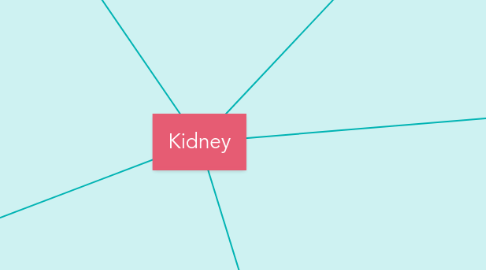
1. Blood Pressure control
1.1. Kidney's auto-regulation maintain constant blood flow to maintain homeostasis during BP fluctuation
1.1.1. Macula densa cells send signals to renin-secreting cells to produce local vasoconstriction to increase GFR and peripheral vasoconstriction to increase BP
1.1.2. Increased BP--> afferent arteriole constriction --> decrease excess flow to decrease pressure transmitted to glomerulus
1.2. Kidney regulate arterial pressure by excreting various amounts of NA+ and H20
2. Acid Base Balance
2.1. Kidney control pH by adjusting the amount of HCO3- that is excreted and reabsorbed
2.2. H+ + HCO3- <--> H2CO3<-->CO2 + H20 the most important extracellualar buffer
2.2.1. H+ drives the equation to the right and generates CO2
2.2.2. CO2 concentration is controlled by aveolar ventilation, H+ and HCO3- concentration is regulated by renal excretion
2.3. Both acid and base has to be present in the solution to donate and accept free H+ ion to maintain constant pH
2.3.1. Acid (pH below 7)
2.3.1.1. Actively excreted into the proximal and distal tubules.-->combines urinary buffers --> free HPO4−2, creatinine, uric acid and ammonia
2.3.1.2. Acid secretion--> determined by arterial pH
2.3.1.3. Acid excretion influenced by K+,Cl- and aldosterone
2.3.2. Base (pH above 7)
2.3.2.1. Molecules that mops up or accept free hydrogen ions
3. Hormone release is essential in controlling the body's BP
4. Electrolytes and hormones works closely to maintain kidney's optimal function
5. Hormones
5.1. Essential in regulating Na+ level and fluid volume
5.1.1. ADH from posterior pituitary
5.1.1.1. Regulate blood volume by increasing permeability of distal tubule and collecting duct to reabsorb H2O
5.1.1.2. Decreased plasma osmolality = decreased ADH secretion via negative feedback system
5.1.2. Aldosterone
5.1.2.1. Activates Na+/ K+ pumps
5.1.2.1.1. Creates a gradient by increasing Na+ re-absorption in blood and increasing K+ and H+ excretion in urine
5.1.2.2. Renin- Angiotensin Aldosterone Pathway
5.1.2.2.1. Regulates system renin release and modulate natriuretic peptides released by the heart
5.1.2.2.2. Important in treating hypertension and heart failure
5.1.2.2.3. ACE inhibitors, receptor blockers, and aldosterone receptor blockers are used to decrease arterial pressure, blood volume, and ventricular preload
5.1.3. Atrial Natriuretic Hormone
5.1.3.1. Inhibits aldosterone secretion, decreased renin and ADH release, and vasodilation
5.1.3.1.1. Excretion of Na+ and H20 through kidney to decrease extracellular fluid volume back to normal
6. Fluid Balance
6.1. Water move between two compartment through osmosis
6.1.1. Increased osmolality --> increased thirst-->increased H20 re-absorption
6.1.2. Na+ and Cl- leading contributor to blood's osmolality
6.1.2.1. Electrolytes
6.1.2.1.1. K+,Na+, Cl- are secreted, reabsorbed, and excreted by nephron
6.1.2.1.2. Na+/ Cl- active re-absorption creates osmotic gradient --> increase H20 re-absorption
6.1.2.1.3. K+ critical in maintaining nerve and muscle excitability
6.2. Urine production is essential to maintain to maintain body osmolality --> excrete body excess solute, concentrate and dilute urine in loop of henle to collecting duct
6.2.1. Blood is filtered in Bowman's capsule and works its way through the neorhon to form urine
6.2.1.1. Re-absorption of nutrients
6.2.1.1.1. Glomerulus and Bowman's capsule
6.2.1.1.2. Proximal tubule
6.2.1.1.3. Loop of Henle
6.2.1.1.4. Distal Tubule
6.2.1.1.5. Collecting duct
6.2.1.2. Secretion of waste products
6.2.1.2.1. Metabolic waste
6.2.1.2.2. Drug metabolites

